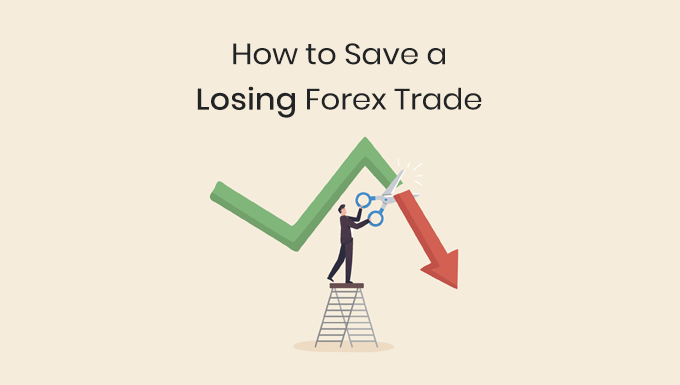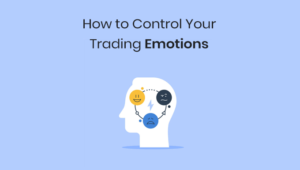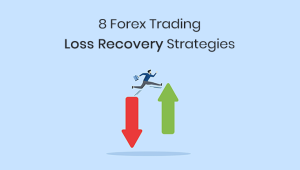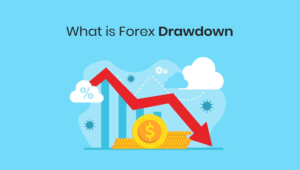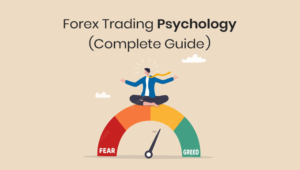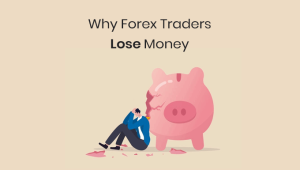As a beginner or seasoned forex trader, facing losses is an inevitable part of the trading journey. In reality that can be scary, especially if the trade starts going in the opposite direction of your analysis. However, the ability to manage these situations is what separates successful traders from those who lose and quit. Now, what should you do if you have a losing trade? How can you save it? Well, this article covers tips on how to save a losing forex trade.
Table of Contents
• Hedging Your Trade
• Scaling Out of Positions
• Diversification of Portfolio
• Using Trailing Stops
• Conclusion
• FAQs
Recognize and Accept the Situation
The Psychological Challenge
Trading is not just a game of numbers; it’s a test of psychological strength. Recognizing a losing position is the first step to saving it. Many traders, especially beginners, find it hard to accept when they are losing, leading them to deny it and make more mistakes.
Importance of Detachment
It’s essential to approach forex trading with detachment. Being too attached to a particular trade can make it hard to make good decisions. When in a losing position, take a step back and analyze the situation with a clear mind, free from emotional bias.
Real-time Analysis
Once you accept the situation, it’s time to get analytical. This means revisiting your initial analysis. Did something change in the market? Was there unexpected news or a sudden economic shift? Understanding what went wrong is crucial for your next steps.
Avoiding the Blame Game
Blaming the market, the broker, or external news sources won’t change the status of your trade. Taking responsibility and looking inward will help you grow as a trader and prevent similar mistakes in the future.
The Power of Stop-Loss
One of the most useful tools at a trader’s disposal is the stop loss feature. It can limit potential losses by automatically closing a trade once it reaches a predetermined loss level. If you haven’t already set one, now might be a good time to consider it.
For example, suppose you buy a EUR/USD pair at 1.1800, expecting the price to rise. To limit your potential loss, you could set a stop loss at 1.1700. This means if the trade goes south, and the price hits 1.1700, the trading platform will automatically close the position, limiting your loss to the predetermined level.
Hedging Your Trade
What is Hedging?
Hedging is another strategy you can employ to save a losing forex trade. It involves opening a new trade in the opposite direction of the losing one. This can help offset the losses from the original trade. By doing so, you can balance potential losses if the market doesn’t move in your favor.
Different Hedging Strategies
There are multiple ways to hedge in forex trading. One common method is spot contracts, while others might opt for forex options. The choice of hedging strategy largely depends on the trader’s prediction of future market movements.
For example, if you’ve gone long (bought) on EUR/USD but the market starts to decline, you could go short (sell) on the same pair to offset your losses. The gain from the short position can then offset the loss from the long position.
Pros and Cons
While hedging can minimize losses, it’s not without its drawbacks. Hedging can sometimes lock in losses or reduce profits. It’s a strategy best suited for those who can quickly analyze market conditions and act decisively.
The Double-edged Sword
Hedging can be a safety net, but it’s also a double-edged sword. If not done correctly, hedging can amplify your losses instead of minimizing them. Always understand the risks involved.
Practicing with Demo Accounts
If you’re new to hedging, start with a demo account. It allows you to practice hedging strategies without risking real money, helping you get a feel for when and how to hedge effectively.
Scaling Out of Positions
Gradual Exit
Instead of closing a losing trade all at once, consider scaling out of it. This means closing a part of your position, allowing the remaining to potentially become profitable.
For example, imagine a trader has opened 3 positions out of which the 1st trade is $100 profit, the 2nd trade is $100 loss, and the 3rd trade is $50 loss. If your analysis suggests that the price might continue on the losing side, then the trader can off-set the 1st and 2nd trades by closing them both together. This will limit further losses if the price goes in the opposite direction of your analysis.
Reducing Exposure
Scaling out helps reduce exposure to a particular market movement. By partially closing a position, you are taking some money off the table, thus reducing potential losses.
For example, imagine a trader has a long position on the GBP/USD pair, predicting that the value of the GBP will rise against the USD. After some time, the GBP/USD starts to move up, but there’s an high impact news event coming up that might impact the GBP negatively. Instead of waiting for the announcement and risking a significant loss, the trader decides to closes 50% of the position to lock in some profit, reducing exposure to potential adverse market movements.
Decision Factors
Several factors come into play when deciding to scale out. These include current market conditions, the reason for the initial trade, and your future market predictions.
Potential Drawbacks
While scaling out can minimize losses, it can also limit potential gains. If the market turns favorable, having a reduced position means lesser profits.
A Prudent Approach
Scaling out should be done prudently. It’s essential to weigh the pros and cons, considering both current market conditions and potential future shifts.
Diversification of Portfolio
Spreading the Risks
Just like the old saying, “Don’t put all your eggs in one basket,” diversification in forex means spreading your investments across different currency pairs or assets. This can reduce the impact of a losing trade.
Currency Correlations
Understanding currency correlations is key. Some currency pairs tend to move in tandem, while others move in opposite directions. By understanding these correlations, traders can better diversify their portfolio.
For example, when EUR/USD rises, USD/CHF tends to fall, and vice versa. This is primarily because both the Swiss Franc (CHF) and Euro (EUR) share a significant relationship due to their geographical proximity and economic ties. For a trader, this means that if they go long (buy) on EUR/USD expecting it to rise, they might also consider going short (sell) on USD/CHF as insurance. If the prediction on EUR/USD goes wrong and it starts to fall, the short position on USD/CHF could potentially compensate for some of those losses as USD/CHF might rise.
Benefits of Diversification
Apart from risk reduction, diversifying can help in achieving more consistent returns. It can offset losses in one trade with gains in another.
Over-diversification
While diversification is good, overdoing it can dilute potential profits. It’s a balancing act. It’s essential to diversify, but equally important to do thorough research and not spread yourself too thin.
Continual Assessment
The forex market is ever-evolving. As such, it’s crucial to continuously assess and adjust your portfolio. What was a well-diversified portfolio last month might not be the case today.
Using Trailing Stops
Dynamic Stop-Loss
Unlike traditional stop-loss, which remains static, a trailing stop moves with the market price. This ensures that you lock in profits as the market moves in your favor, while also providing protection against reversals.
For example, let’s say you bought a EUR/USD pair at 1.1800, and you set a trailing stop 100 pips below your entry point. Now, if the price rises to 1.1900, the trailing stop would automatically move up to 1.1800, protecting your profit. If the price then falls back to 1.1800, the trailing stop would trigger, and your position would be sold.
Setting the Right Distance
The key to a successful trailing stop is setting the right distance from the market price. Set it too close, and you risk being stopped out prematurely. Set it too far, and you might not protect your profits effectively.
Automatic vs. Manual
Many trading platforms offer automatic trailing stops, adjusting the stop level dynamically. However, some traders prefer manual adjustments to have more control over their trades.
The Psychological Benefit
Trailing stops can also serve a psychological purpose. Knowing that there’s a mechanism in place to protect profits can give traders peace of mind, allowing them to focus on other trades or market analysis.
Conclusion
Dealing with a losing forex trade can be mentally stressful. It’s crucial to maintain good trading discipline with a calm and composed mindset during such times. Remember, every trader experience loss at some point. While every trader would like to save a losing forex trade, sometimes the best course of action might be to accept the loss and learn from the experience. The key is learning from these losses and continuously improving your trading strategy. Whether you choose to adjust your stop loss, take profit levels, trailing stops, hedge your trade, or close the trade altogether, remember that the objective is to minimize losses and protect your trading capital. After all, a successful trader is not the one who never experiences losses but the one who knows how to manage them.
FAQs
Q: What is a losing forex trade?
A: A losing forex trade is a trade where the currency pair you’ve invested in is moving in the opposite direction of your prediction, leading to potential losses.
Q: What is hedging in forex trading?
A: Hedging in forex trading is a risk management strategy where a trader opens a new trade in the opposite direction of a losing trade to offset losses.
Q: How can I minimize losses in forex trading?
A: To minimize losses in forex trading, you can employ strategies like setting appropriate stop loss and take profit levels, managing your risk/reward ratio, and using hedging strategies.
Q: Is it normal to experience losses in forex trading?
A: Yes, experiencing losses in forex trading is normal. The forex market is highly volatile, and predicting its movements with 100% accuracy is impossible.
Q: What should I do if my forex trade is losing?
A: If your forex trade is losing, you can identify the cause of the loss, make necessary adjustments to your trade, or even consider closing the trade to minimize losses. The key is to make a decision that best protects your trading capital.
